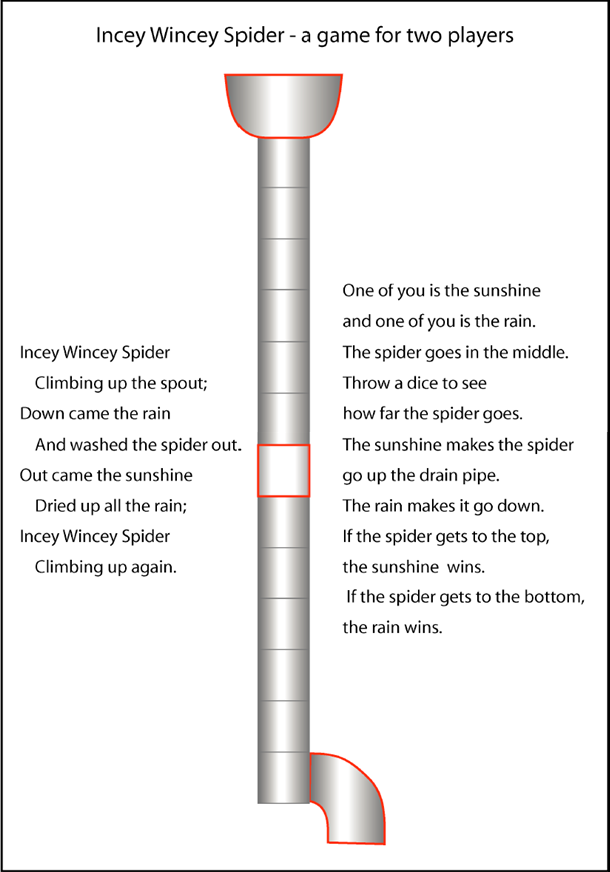Or search by topic
Number and algebra
Geometry and measure
Probability and statistics
Working mathematically
Advanced mathematics
For younger learners
Incey Wincey Spider



- Problem
- Getting Started
- Student Solutions
- Teachers' Resources

This is a game for two players. To play, you'll need two dice, a paper version of the drainpipe (in colour or black and white) and a counter to be the spider.
Start by playing with one dice.
Decide who is the sunshine and who is the rain. Take it in turns to throw the dice and move the spider that number of spaces up (sunshine) or down (rain).
If the spider gets right to the top of the pipe, sunshine wins. If it gets to the bottom, rain wins.
Next, try a more interesting version of the game. This time, use two dice. In this game, the player must land exactly on the end of the drain pipe to win. For each turn decide which dice number to use.
You could make up your own version of the game, and perhaps send in you ideas to us so that other children can try them out. What makes the game good to play?
Teacher resources for this activity can be found here.
Printable NRICH Roadshow resource and spider counters: Spider1.pdf or Spider2.pdf
Why play this game?
This game is designed to get children used to moving along a track either side of a central point. This makes it a great precursor to negative numbers. It also introduces children to a vertical number track, which they may not have seen before.
Possible approach
A possible starting point is to remind children of the rhyme, saying it through and getting them to move their hands up and down appropriately.
Climbing up the spout;
Down came the rain
And washed the spider out.
Out came the sunshine
And dried up all the rain;
Incey Wincey spider
Climbing up again.
Real dice will be needed to play the game.
Children need to understand that one of them is the sunshine and one of them is the rain. Sunshine moves the spider up the drain pipe and rain moves the spider down. Sometimes one child will claim to be the spider! If the spider gets right to the top of the pipe, sunshine wins and if it gets to the bottom, rain wins.
Once the way to play the game is understood, children can play in pairs, taking turns to be the sunshine and the rain so they get the experience of moving both up and down.
You can print out a paper version of the game which could be laminated for long-term use. Here is a black and white copy, and here is a colour copy. Both have a spider picture on the second page which could be cut out and stuck onto an ordinary
counter.
Those who master the idea quickly can move on to the a second version of the game using two dice. (See possible extension below.)
Key questions
Are you the sunshine or the rain?
Do you move up or down when it is your turn?
How many spaces are there between the spider and your end of the drain pipe?
Possible extension
There is a second version of the game in which players throw two dice and choose which number displayed to use. In this way, the players can move the number of spaces that suits them best. This is therefore at a higher level as a decision has to be made, rather than relying solely on chance.
The game Tug of War is based on very similar ideas but uses a horizontal number line rather than a vertical track, and introduces further decision making.
Possible support
Encourage children to say the rhyme moving their hands so they understand which way the rain and sunshine make the spider move.
If players are still experiencing problems, try using a more familiar horizontal number track.
You may also like
Adding with the Abacus
Nowadays the calculator is very familiar to many of us. What did people do to save time working out more difficult problems before the calculator existed?
Jumping Squares
In this problem it is not the squares that jump, you do the jumping! The idea is to go round the track in as few jumps as possible.
All Change
There are three versions of this challenge. The idea is to change the colour of all the spots on the grid. Can you do it in fewer throws of the dice?

